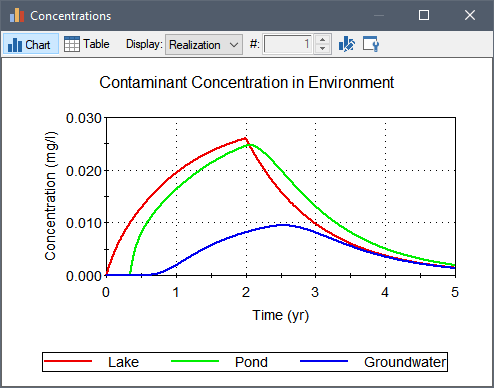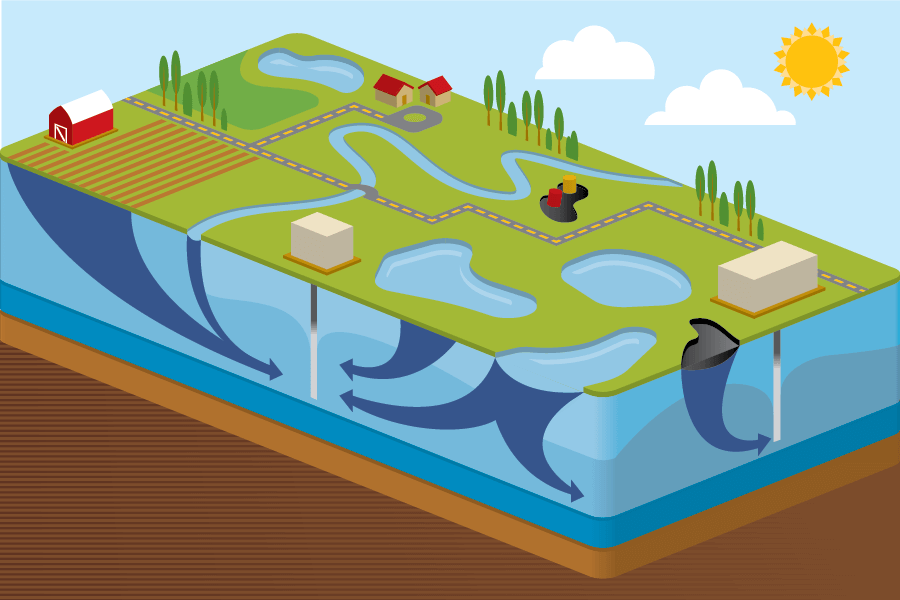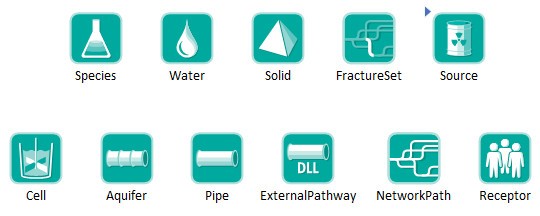Features and Capabilities
What Can the Contaminant Transport Module Do?
A mass transport model is a mathematical representation of an actual system (e.g., the subsurface environment) that can be used to simulate (and hence predict) the release, transport (movement) and ultimate fate of mass within the system. The "mass" that is typically simulated is that of chemical contaminants that have been accidentally released or intentionally disposed of within the system. As a result, such models are often referred to as contaminant transport models.
The Contaminant Transport Module facilitates the simulation of both simple and complex contaminant transport problems.
What kind of problems can be simulated using the GoldSim Contaminant Transport Module?
You can apply GoldSim Contaminant Transport Module to a wide variety of problems, such as:
- Investigation of the transport and fate of contaminants (or natural components) in aquifers, wetlands, lakes and other complex ecosystems;
- Evaluation of the performance of existing or proposed landfills, hazardous waste sites and engineered disposal facilities; and
- Simulation of the transport and fate of pharmaceuticals and other compounds within biological systems (e.g., physiologically-based pharmacokinetic modeling).

What processes can be simulated using the GoldSim Contaminant Transport Module?
The Contaminant Transport Module allows the user to explicitly represent the following processes:
- Release of mass (e.g., contaminants) from specified sources, taking into account both the failure of containers (e.g., drums) in which the contaminants are disposed; and the degradation of any materials in which the contaminants are bound (e.g., grout, metal, glass). (This feature is available in GoldSim RT only).
 Transport of contaminants through multiple transport pathways within an environmental system (e.g., aquifers, streams, atmosphere). The transport pathways can consist of multiple transport and storage media (e.g., groundwater, surface water, air, soil), and both advective and diffusive transport mechanisms can be directly simulated. Transport processes incorporate solubility constraints and partitioning of contaminants between the media present in the system, and can include the effects of complex chemical reactions and decay processes.
Transport of contaminants through multiple transport pathways within an environmental system (e.g., aquifers, streams, atmosphere). The transport pathways can consist of multiple transport and storage media (e.g., groundwater, surface water, air, soil), and both advective and diffusive transport mechanisms can be directly simulated. Transport processes incorporate solubility constraints and partitioning of contaminants between the media present in the system, and can include the effects of complex chemical reactions and decay processes.- Biological transfer of contaminants within organisms. Like physical transport pathways, biological transport pathways can consist of any number of transport and storage media (e.g., blood, tissue) which can be linked by a variety of transport mechanisms.
In addition, GoldSim can be linked directly to geochemical equilibrium codes in order to simulate complex geochemical processes.
How does the GoldSim Contaminant Transport Module provide this functionality?
The Contaminant Transport Module provides this functionality by adding specialized elements for representing contaminant species, transport media, transport pathways, contaminant sources, and receptors to the GoldSim simulation framework:

By linking these specialized elements together (and integrating them with GoldSim's basic elements), you can repesent complex processes and systems:

Where has the GoldSim Contaminant Transport Module been used?
The GoldSim Contaminant Transport Module has been used to address complex contaminant transport problems worldwide. Most of these applications have been in the areas of radioactive waste management, mining and water resources. A number of these applications can be seen by browsing technical papers that utilize GoldSim.
Learn More
Read an Excerpt from the GoldSim Contaminant Transport Module User's Guide
